Killing Termites

Don’t Get Too Comfortable
You haven’t killed all the termites with a can of spray or because you removed the damaged timber.
Killing Termites Only Ends by Killing the QUEEN!
An established termite nest/colony may contain a million or more termites and the queen of a large termite colony may be laying a thousand or more eggs a day!
If you begin repairs before killing the termite colony, in many instances you have just given them a new source of food.
The chances are extremely high, the termites will be back.
Or you may be tempted to have a new chemical/pesticide barrier applied
But this doesn’t guarantee that the currently hidden entry point will be found and defended by this chemical application.
You can’t jack up a house to start again.
To kill termite colonies and the Queen, termite baiting is considered to be the most reliable method.
If you’ve found termites and disturbed them, your first action is to ‘gently’ try and find other infested timbers and begin baiting.
If You’ve Found Live Termites Busy Eating Timber, You’ll Need to Use Termite Bait on the Outside of the Timber
They will carry it back to kill their colony.
Here’s a Step by Step to Killing Termites – Termite Monitors
A TermiTrap (aka a termite monitor), is a decoy for discovering termite activities.
When termite scouts are out discovering the next food source, a Termitrap pretends to be the right amount of wood as a fallen tree. Termites don’t know it’s not a tree… not that they care, it’s wood that is perfect for their next meal and builds tunnels to harvest it
How Termite Monitors Work with Colony Killer Termite Bait
Step 1
Add Termite Monitors
Place termitraps around your home, spacing about 3 meters apart and in areas of concern.

Once termites move into a TermiTrap, termites will seal from the bottom and set up the area for harvesting.
Worker termites will then start eating the timber and soldier termites will defend the area should a hole appear in that air-tight mud seal
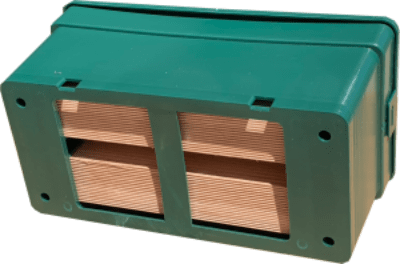
Step 2
Identify Termite Activity
This mud seal will happen without you noticing, usually.
But there’s no need to open the TermiTrap as the hole on the top will be blocked out by the termites’ mud
The termites’ aim is to make the feeding area air-tight, safe working temp and safe from ants.
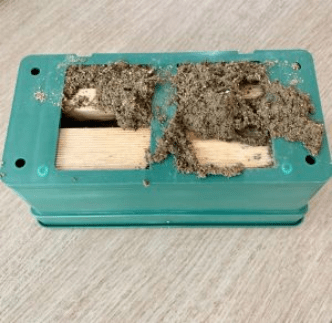
Here’s what it looks like when termites seal the hole in the top of the Termite monitor.
Checking TermiTraps is much easy than trying to walk around your home and trying to discover termite activity

Congratulations!
You know how to set up a system of termite monitors that’s perfect for killing termites, but won’t harm you, your family or your pets.
You will be using the same technique a professional pest controller will be using, but you are saving hundreds, maybe thousands of dollars in the process
Step 3
Time to Add Termite Bait
Now we have termites signalling they are in the termite monitor, it’s time for killing the termites.
Just like the professionals, you will use a Termite Bait with an insect growth inhibitor called Chlorfluazuron, Colony Killer Termite Bait.
Always read the label, detailed instructions make killing termites easy work.
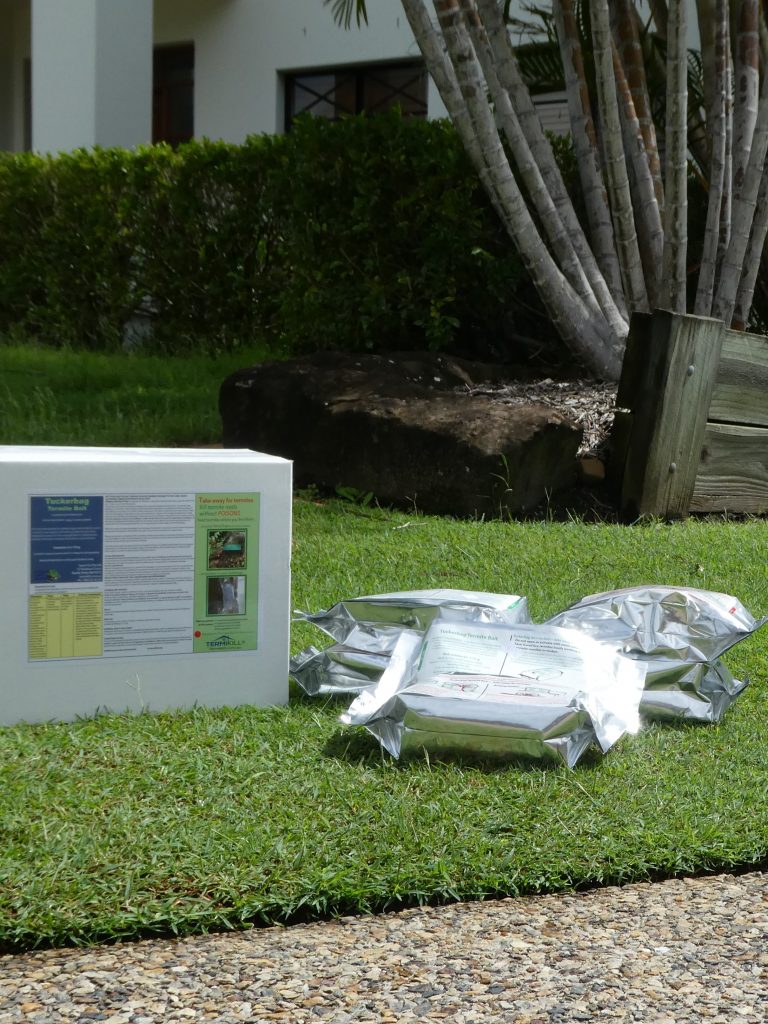
Add water to the Colony Killer Termite Bait, but not tap water, distilled water is best.
Yes, a trip to your local supermarket is beneficial, distilled water has the best flavour for termites… none. No impurities mean no reason for the termites not to take the termite bait.
You don’t want to get this close to killing termites, not just a few but the whole termite colony
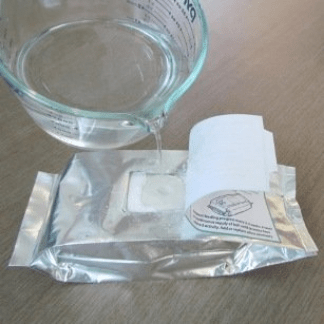
Ready… Push the mud (top hole) in and attach the Colony Killer Termite Bait directly to the top of the Termitrap.
A little press on the pouch so the termite bait oozes a little into the hole where the mud was (you’re remaking the seal saving the termites some work)
And now the hardest part… No touching or feeling the termite pouch for at least a week.
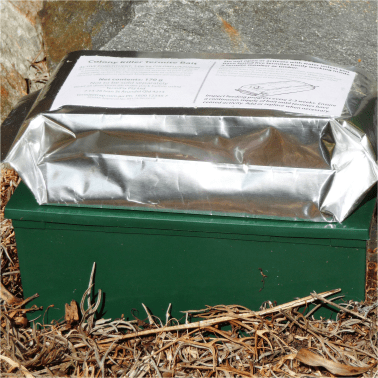
Here’s a Step by Step – Termite Bait on timber
Adding Termite Bait where Termites are Actively Eating Timber
Step 1:
Don’t Disturb Them!
You may want to pull things apart to see how far the damage goes.
Don’t.
This will have the effect of scaring termite workers from the area and you need termites to be the carriers of the termite bait back to the nest so they can kill the rest of the termite colony.

Step 2:
Make a Small Hole
Make a hole in the area where you know there are termites, like this
As you have already tested that the soldier termites come out and defend the hole till the termite workers repair the hole.
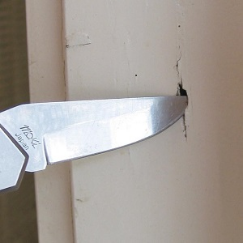
Step 3:
Prepare a Termite Bait Pouch
Our Colony Killer Termite Bait is filled with an insect growth inhibitor called Chlorfluazuron – it’s deadly to the life cycle of termites, but won’t harm you, your family or pets.
You peel open the adhesive on the top and add water…
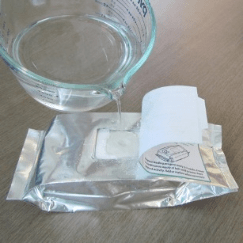
Then you place the opening of the hole over the affected area.
The termite bait pouches have an adhesive on them so they can be stuck directly to affected areas.
Here the Colony Killer Termite bait its been added to a fence post where termites were found. . .
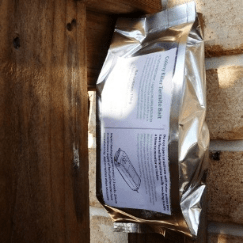
Here the Colony Killer Termite Bait has been stuck to the architrave of a window . . .
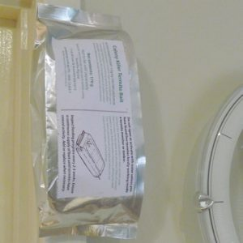
Step 4:
Termites Harvest the Bait
Taking it back to the nest where it kills the whole termite colony
larger nests will need more than one pouch of Termite bait.
Wanting to know more about defending your home against termites.
Also lots of easy to understand instructions in our How To Guide.
In Summary – Killing Termites
The termites that attack homes follow the same instincts they’ve used for millions of years. These few instincts are predictable. You can help kill termites by following these recommendations — and be just as predictably successful.
We Use This Instinct
Against Termites
The worker termite’s main job is to find food, chew off a tummy full and return to the nest to feed the nymphs and Royalty.
Workers are like an endless conveyor belt. It’s what they do.
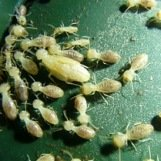
How We Use This Instinct
By feeding termites an IGR bait which is more palatable, they take it back, instead of chewed wood.
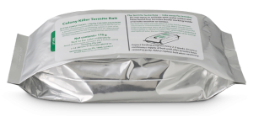
What Happens
The termite bait contains a chemical that stops their moulting process and the viability of the queen’s eggs. The termite colony is killed.
It may take a while but it is the most consistently reliable control method. Professionals use the same technique and the same bait — have done for 15+ years — because it works!
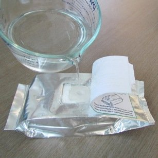
What You Use
The carton of Colony Killer Termite Bait is usually enough to kill a large colony or a couple of smaller termite colonies. What you don’t use will store for years.
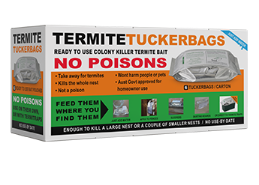
Additional Killing Termites Information
You can download our free How-to-Guide
Check out the rest of our website and shop
OR speak to a friendly, helpful human… 1800 20 30 20
OR click here to open a chat
Questions & Answers
What Kills Termites Instantly?
Nearly everything kills termites once they are outside of the safety of the nest
Killing the Queen kills the colony not killing individual termites
How do you Get Rid of Termites Yourself?
The simplest way is to use the same products and techniques the professionals do
Professionals use IGR (insect growth regulator) which is taken back to the nest and kills the Queen
What is the Best to Kill Termites?
IGR Baits (insect growth regulator) give the best consistent results.
Termites harvest the IGR and it takes back to the nest and kills the whole colony.
Can I Treat my Home to Termites Myself?
Yes, and it’s cheaper than getting in a professional.
Add a termite Bait pouch to the area of Termite activity and the Termites do the rest.
I’ve Found Termites in the Garden
Live termites found scurrying through the mulch, leaf litter, in a load of firewood, etc, are not in a situation where they are able to be baited. Plenty of people have placed bait in mulch where they saw termites —but it doesn’t work.
Probably because the termites could not secure the bait from ants or, they didn’t have secure tunnel access.
The best procedure is to place multiple Traps in the area and wait for them to access the Traps in their usual way. You can then use a termite bait to kill the termites.
Found in Fences, Retaining Walls, Stacked Timber or the Firewood Heap.
These items are made of solid wood and therefore the termites may well be Coptos or Schedos. They could also be one of the not-so-serious termites.
We recommend getting them identified; they won’t eat much in the few days or hours it takes. Photos not only of the soldiers but also of the mud on the fence, wall or timber can be a useful aid to identification.
We can then advise the best treatment method for killing these termites.
I’ve Found Termites Inside a Hollow Stump or a Hollow Tree
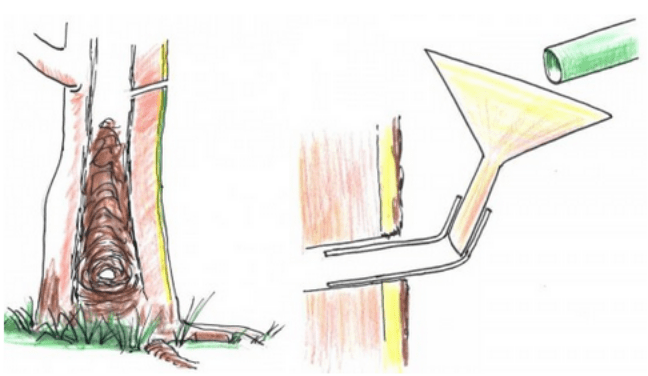
Coptos and Schedos often build their nest inside hollow trees and stumps.
So do a few other species, but as it is very easy to kill termite nests inside trees, it should be done no matter which species it is.
The treatment will not kill the tree and, although insecticides are used, they are poured down the inside of the tree and remain there away from people, pets and wildlife.
Follow label instructions on dilution and the use of protective procedures.
The insecticide inside the tree will last for about 10 years but setting Traps around the buildings is still recommended because termites don’t only set up nests in trees —and we know for sure, that termites are in your neighbourhood!
I’ve Found Termite Nests in the Branches of Trees
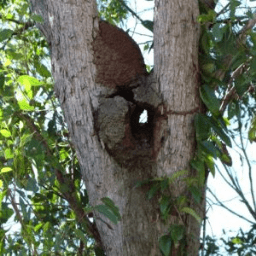
These termites are either feeding on the decaying interior of the tree or they build tunnels down the outside which then radiate out in many directions (often on top of the ground) to grass and leaf litter.
If you can easily reach the nest, physically destroy it as for mounds built on the ground, otherwise, you can keep breaking their tunnels and maybe spray insecticide around the base of the tree to eventually ‘starve’ them out.
You could, of course, get an arborist to climb up and cut the nest out.
You could even drill into the trunk of the tree and inject bifenthrin by following the instructions in this section. Just because you have mounds, it doesn’t mean the other, more significant Coptos and Schedos aren’t around.
You should consider putting TermiTrap monitors out to intercept them just in case they are. Kill these termites and stop them in their tracks.
I’ve Found Termites Plastering a fence
These are probably Heterotermes which are more interested in the fungus growing on the surface of timber such as paling fences, sleepers in retaining walls, etc.
They come from the soil and they certainly have been known to find a way inside a house through weepholes. They seldom get into an outside monitor and the Colony Killer Termite Bait is of little use as they don’t build a substantial nest. Probably the easiest way to kill these termites is to brush off the plastered ‘mud’ mixture and spray the area with a bifenthrin or permethrin solution made from a concentrate bought from your local hardware store.
You should also apply a high volume along the line where the fence touches the ground and particularly around the posts. This is best done with a watering can so there is no droplet drift and the soil is saturated. The residue in the soil will last for about 5-10 years. And, because you can’t be sure you’ve actually killed the termite nest by destroying thousands of soldiers and workers, you should inspect the area (and your house) every 3 months for the next year.
Re-do if necessary. You can use our Photo ID service to help you in identifying your termites. Once you have identified them as nasties, it’s time to get on with killing the termites.
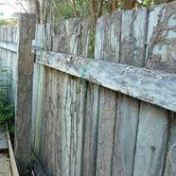
You Can’t be Sure You’ve Actually Killed the Termite Nest
You should inspect the area and your house every 3 months for the next year.
I’m in the North and Have Found Giant Termites
The Giant Northern Termite Mastotermes darwiniensis destroys houses, trees, vehicle tyres (yes, rubber tyres!) and many other materials, faster than any other termite.
They don’t cause the most dollars worth of damage in Australia; that title goes to the Coptos, simply because Coptos are distributed over all the mainland (including where Mastos thrive) and consequently they run up their dollars in the high population cities/suburbs.
Identification is pretty easy: Mastos are 13-15mm long (that’s more than half an inch). Most other termites are less than 10mm. They don’t build big mounds; those magnetic (north-south) mounds up your way are grass eaters. Mastos are easy to entice into monitors. Inspect monitors every month as they eat quickly.
If you find live Mastos, the IGR (chloruazuron) baits are ineffective. You will need to call in a professional who will probably use a fipronil product to kill the termite infestation.
If you are apprehensive of chemicals, do not worry unduly. Fipronil is the chemical in Frontline which is put directly onto the skin of dogs to kill and prevent fleas, so the usual dilution of 3 ml/litre of fipronil is even less toxic.

Destroys Houses, Trees, Vehicle Tyres and Many Other Materials
Faster than any other termite.
I’ve Found Termites in Mounds
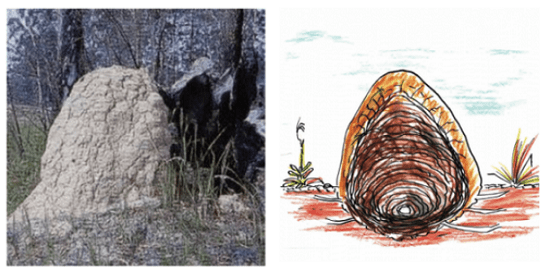
Just completely destroy the mound to kill these termites. Termites that build mounds are subterranean but not included in the termites that do 99% of the $damage to homes. This is because mounds are very visible, not tolerated around buildings and it is very easy to kill these termite colonies by physically destroying the mound. If you are on an acreage property, make it your rule not to allow any mounds to develop within 100 metres of a building or other structure.
If you live in suburbia and there are no mounds in your backyard, take a glance over your fences to see if the neighbours have mounds. A 50-metre travel to your home would not be out of the question.
Use a crowbar, a pick/mattock to break open the top/sides. The outer is often very hard. The less dense and crumbly interior is easier to break. The queen and the nursery are at the base of the mound and if you can’t physically get down there, use 30-50 litres of the dilute insecticidal mixture of permethrin, chlorpyrifos or a bifenthrin concentrate which can be purchased from a local hardware store.
These insecticides may be known by various brand names but the active ingredients are on the front panel of the label. Although not highly toxic, they are poisons and you should read the label for dilution and safety directions. Using a watering can/bucket, pour at least 30-50 litres of solution down into the mound. It’s more important to use high volume than a high concentration.
You want it to percolate all the way down to the bottom to kill off the queen. The colony will be re-built in weeks if you don’t.

